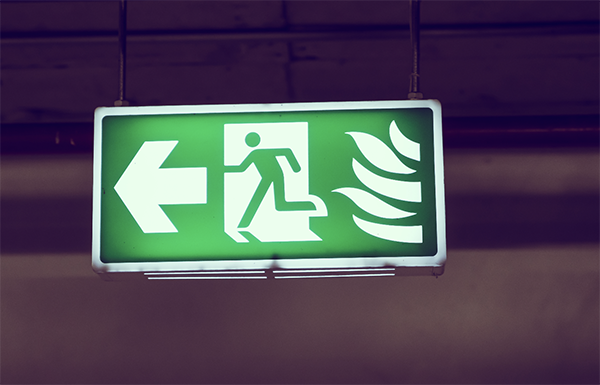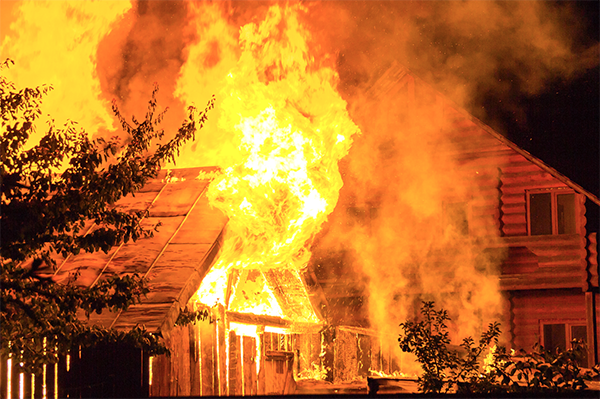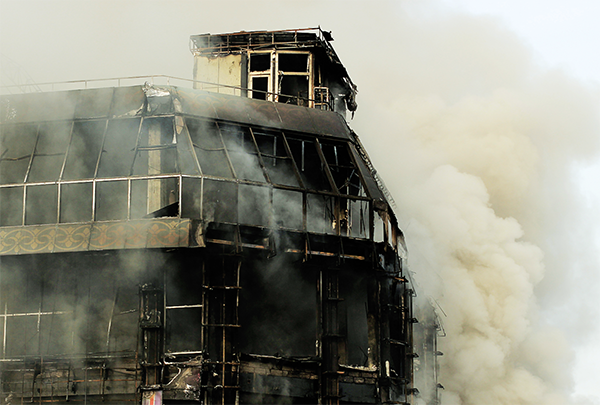How to Protect Yourself
Sometimes fires are out of our control and there’s little we can do to prevent them — especially when they’re caused by Mother Nature. Lightning can cause electrical power surges, which can set off a fire in or near a home. Forest wildfires can consume entire neighborhoods. Hurricanes, floods, tornadoes, and earthquakes can also create fires if they damage heating or electrical devices in a way that causes the equipment (or the material around the equipment) to combust.
But whether a fire starts due to carelessness or an act of nature, the steps to take before, during, and after remain the same.

Emergency Preparedness
Fire Safety Natural Disasters Helpful LinksBefore a Fire
Luckily, you can minimize your risk of falling victim to a fire by following these simple steps.- Make a fire escape plan by gathering everyone in your household, walking through your home, and inspecting all possible exits and escape routes.
- Identify two escape routes out of each room, if possible, and make sure each of those escape routes can be used safely by everyone.
- If your household has children, draw a floor plan of your home and mark each escape route (including windows and doors) as well as the location of each smoke alarm. (Download our “How to Make a Home Fire Escape Plan” for help with this.)
- Practice your home fire escape plan at least twice a year.
- When you practice your fire escape plan, make sure escape routes are clear and doors and windows can be opened easily. Items that block doors and windows in your home could keep you from escaping in the event of a home fire.
- Closed doors may slow the spread of smoke, heat, and fire, so keep bedroom doors closed at night.
- Install smoke alarms in every sleeping room, outside each sleeping area, and on every level of the home (see more in the Install Smoke Alarms section of the website).
- Choose an outside meeting place (e.g., neighbor's house, light post, mailbox, stop sign) a safe distance in front of your home where everyone can meet after they've escaped. Mark the location of this meeting place on your escape plan.
- Ensure your street number is clearly visible from the road. If not, paint it on the curb or install house numbers to ensure responding emergency personnel can find your home.
- Have everyone memorize the emergency phone number of the fire department so any member of the household can call from a neighbor's home or a cellular phone once safely outside.
- If you own your home and cannot afford smoke alarms, or you need help installing alarms you already have, you can go by your local fire station for assistance. If you reside in South Montgomery County, call the South Montgomery County Fire Department at (281) 363-3473 to schedule an appointment for smoke alarm assistance.
- Make digital copies of valuable documents and records, like birth certificates.
- Sleep with your door closed.
- Contact the fire department for information on training on the proper use and maintenance of fire extinguishers.
- Consider installing an automatic fire sprinkler system in your residence.
- Never use your stove or oven to heat your home.
- Keep combustible and flammable liquids away from heat sources.
- Portable generators should NEVER be used indoors. Also, they should be refueled only outdoors or in well ventilated areas.


During a Fire
- Crawl low under any smoke to your exit, because heavy smoke and poisonous gases collect first along the ceiling.
- Before opening a door, feel the doorknob and door. If either is hot, or if there’s smoke coming in from around the door, leave the door closed and use your second way out.
- If you open a door, open it slowly. Be ready to shut it quickly if heavy smoke or fire is present.
- If you can’t get to someone needing assistance, leave the home and call 9-1-1 or the fire department. Tell the emergency operator where the person is located.
- If pets are trapped inside your home, tell firefighters right away.
- If you can’t get out, close the door and cover vents and cracks around doors with cloth or tape to keep smoke out. Call 9-1-1 or the fire department. Say where you are, and signal for help at the window with a light-colored cloth or a flashlight.
- If your clothes catch fire, stop, drop, and roll: Stop immediately, drop to the ground, and cover your face with your hands. Roll back and forth until the fire is out. If you or someone else cannot stop, drop, and roll, smother the flames with a blanket or towel. Use cool water to treat the burn immediately for three to five minutes. Cover burns with a clean, dry cloth, and get medical help right away by calling 9-1-1 or the fire department.
After a Fire
The following checklist serves as a quick reference and guide to follow after a fire strikes.- If you’re insured, contact your insurance company for detailed instructions on protecting your property, conducting inventory, and contacting fire damage restoration companies. If you’re uninsured, try contacting private organizations for aid and assistance.
- Contact your local disaster relief service, such as The Red Cross, if you need temporary housing, food, or medicine.
- Check with the fire department to ensure your residence is safe to enter. Be mindful of any potential structural damage caused by the fire.
- Have the fire department confirm that utilities are either safe to use or are disconnected before they leave the site. Don’t attempt to reconnect utilities yourself.
- Conduct an inventory of damaged property and items. Don’t throw away any damaged goods until after that inventory.
- Try to locate valuable documents and records. Refer to information on contacts and the replacement process .
- Begin saving receipts for any money you spend related to fire loss. The receipts may be needed later by the insurance company and for verifying losses you claim on your income tax return.
- Notify your mortgage company of a home fire.




